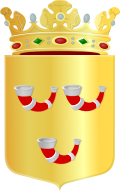This article has an unclear citation style .(September 2009) |
| House of Hornes Huis Horne | |
|---|---|
 | |
| Country | |
| Titles | Lords of Loqueren Lords of Gaesbeecq Lords of Houtekercque Viscounts of Furnes Counts of Bassignies Princes of Hornes |
| Estate(s) | Gaasbeek Castle Horn Castle |
| Dissolution | 1826 |
| Cadet branches | Hornes-Bassignies |




The House of Hornes was an old and important European noble family, which became extinct in the male line in 1826. The name refers to Horn, a small village in Limburg, located in the Netherlands.